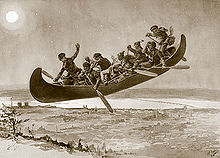Canadian folklore
| Part of a series on the |
| Culture of Canada |
|---|
Canadian folklore is the traditional material that Canadians pass down from generation to generation, either as oral literature or "by custom or practice".[1] It includes songs, legends, jokes, rhymes, proverbs, weather lore, superstitions, and practices such as traditional food-making and craft-making. The largest bodies of folklore in Canada belong to the aboriginal and French-Canadian cultures. English-Canadian folklore and the folklore of recent immigrant groups have added to the country's folk.
Indigenous folklore and mythology

The classic definitions of
It is very difficult for a stranger to rightly understand the morals of their stories [...] And when you have learned all that language can convey, there are still a thousand images, suggestions and associations recurring to the Indian, which can strike no chord in your heart. The myriad voices of nature are dumb to you, but to them they are full of life and power.[5]
Among many Native cultures, "storytelling" was normally restricted to the long winter evenings. The Cree were one culture with a strict belief in this regard: "During the summer, no stories founded on fiction were ever told; the Indigenous peoples believing that if any 'fairy' tales were told during that season when they were supposed to use their time to best advantage, the narrator would have his life destroyed by the lizard, which would suck his blood."[6]
Indigenous folklore and
Themes and genres
Some broad themes can be identified in Indigenous Canadian mythology.
One creation myth from the
Supernatural beings are prominent in many myths about the origin of places, animals, and other natural phenomena.
French-Canadian folklore
French-Canadian folklore has its roots in the folklore of France, with some stock characters such as Ti-Jean, the everyman character.[11] Other popular heroes of French-Canadian folklore were created in New France, such as the exploits of the hunter Dalbec, and the voyageur Jean Cadieux. The earliest French-Canadian folksong celebrates the adventures of Jean Cadieux.[12]

Loup-garou (werewolves) and shape-shifting sorcerers turning into animals such as owls or bears "to torture their enemies" are widespread in French-Canadian legends.[13] The presence of demons and priests in many French-Canadian legends attests to the dominant presence of the Catholic church and its rituals in everyday life[14] in New France and Acadia.
The folklore of the
The folklore of French Canada includes some rituals associated with Church holidays. The Temps des fêtes (
A recent folk tradition that adapts a custom from France is the Tintamarre parade of Acadia, similar to France's Medieval Charivari festivities.
English-Canadian folklore
Early English-Canadian folklore has several points of origin, due to the various settler groups that came to the country from England, Scotland, Ireland, and as Loyalists following the American Revolutionary War. Each group brought their own traditions and created new folklore in their new homeland. In the generations since the early settlers, waves of immigrants have come to Canada from around the world, adding their own folklore to the country's mix.
Oral traditions in Canada mainly have a regional or community-based identity.
Atlantic provinces
The music and folklore of Newfoundland's people are influenced by their ancestors, settlers who mainly came from south east Ireland (
Ghost stories figure prominently in the folklore of the Atlantic provinces. One example is the story of the Dungarvon Whooper, a tale involving a logger from the Dungarvon River near Miramichi, New Brunswick in the 1860s. According to the legend, the logger murdered a camp cook for his money. It has been claimed that eerie screams and howls have been heard in the woods near the Dungarvon River ever since.[22]
Central Canada
Some popular folklore in Canada involves lore connected with actual historical people, such as the "
Lumberjack heroes are one genre of Canadian folklore that spread throughout the
Canadian Prairies
Among the later immigrant groups to Canada, the folklore of settlers in the western
Northern Canada
Folk tales about the adventurers in northern Canada (particularly about the Yukon's Klondike Gold Rush era) provide more examples of folk heroes based on real historical people. These include the stories told about Sam Steele and "Klondike Kate" (Kathleen Rockwell). Verse ballads by poet Robert Service told tall tales about colourful Klondike characters, such as The Cremation of Sam McGee and The Shooting of Dan McGrew. The poems were partly based on real events and people, but through popular repetition grew into folklore.[26]
See also
- Events of National Historic Significance
- Heritage Minutes - integrate Canadian history, folklore and myths into dramatic storylines.
- National Historic Sites of Canada
- Persons of National Historic Significance
References
- ISBN 0771032048.
- ISBN 0771032048.
- ISBN 9781433112713.
- ISBN 0771021216.
- ISBN 0771021216.
- ISBN 0771021216.
- ISBN 9788122305487.
- ISBN 9780756642211.
- ISBN 0771021216.
- ISBN 0771021216.
- ISBN 9780874834819.
- ISBN 9780802029386.
- ISBN 9780226158594.
- ISBN 9781135578787.
- ISBN 9781135578787.
- ISBN 9781576070895.
- ISBN 9781134468485.
- ISBN 9789280507553.
- ISBN 9781897425596.
- ISBN 9780192100191.
- ^ ISBN 9781770704695.
- ISBN 9780888822222.
- ISBN 9781897113318.
- ISBN 9780870204715.
- ISBN 9781135578787.
- ^ Point Park College; Pennsylvania Folklore Society; Lycoming College (1956). "Folklore". Keystone Folklore Quarterly. 1–3. Simon Bronner: 56.

